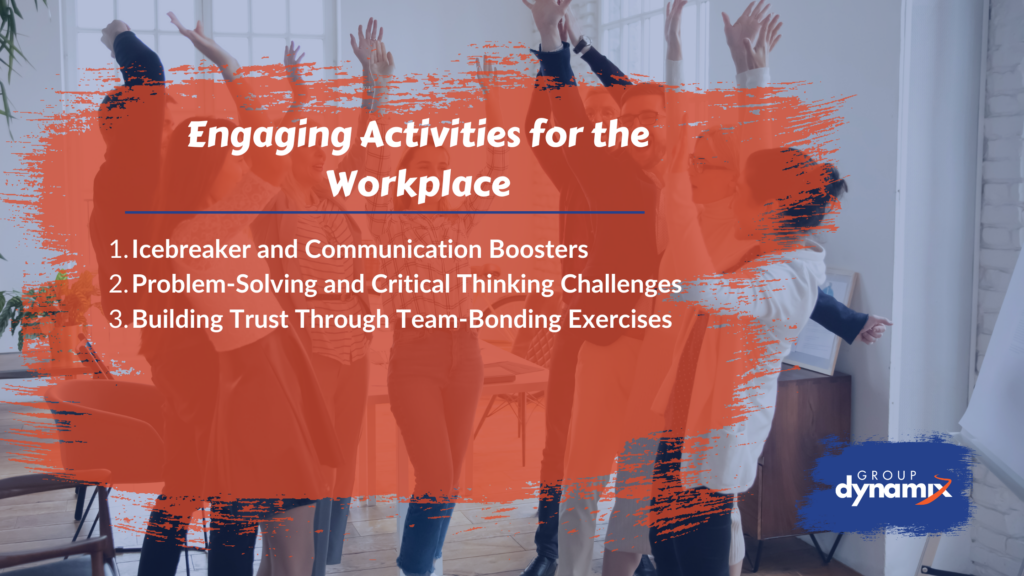Ever noticed how some workplaces buzz with energy while others feel like a never-ending Monday? The difference often boils down to employee motivation. In today’s competitive business world, keeping your team engaged isn’t just nice—it’s essential. Highly engaged teams boost profitability by 21%, directly impacting your bottom line.
Let’s explore some practical, proven activities that can transform your workplace energy and create an environment where people actually want to excel.
If you’re ready to elevate your team’s motivation and performance, connect with Group Dynamix today. Discover tailored solutions that foster collaboration and energize your workplace culture!
Benefits of Team Building
Benefits of Team Building
Table of Contents

The Organization-Wide Impact of Motivated Staff
When employees feel motivated, the effects spread throughout your entire organization. Motivated employees are 20% more productive—they think more creatively, take smart risks, and share ideas that drive progress. This productivity boost directly helps your organization meet goals and grow sustainably.
Beyond productivity, teams with high morale experience a 41% reduction in absenteeism. When people feel invested in their work, they show up consistently, keeping projects on track and maintaining momentum. This reliability creates a solid foundation for your business operations.
Perhaps most impressive, motivated employees are 87% less likely to quit. With recruitment costs constantly rising, keeping good people becomes a major competitive advantage. Companies that invest in employee motivation save big on hiring and training while preserving valuable institutional knowledge.
The impact extends to customer relationships too. Engaged employees build stronger connections with clients, representing your brand with genuine enthusiasm rather than rehearsed scripts. This authentic interaction leads to happier customers and greater loyalty, directly affecting your revenue and reputation.

Motivation Through Interaction: Engaging Activities for the Workplace
Interactive activities can transform workplace dynamics and build stronger teams. When done right, these activities break down barriers, spark creativity, and create meaningful connections that last long after the exercises end. Here are some of the most effective engagement activities to revitalize your team’s spirit.
Icebreaker and Communication Boosters
Game of Two Truths and a Lie
This classic icebreaker remains incredibly effective because it combines personal storytelling with a fun challenge. Each team member shares three statements about themselves—two true and one false—while others guess which is the lie.
Beyond the laughs, Two Truths and a Lie reveals surprising personal details that help colleagues see each other as real people, not just coworkers. The activity encourages active listening and helps team members discover unexpected things in common, strengthening workplace bonds in minutes.
Team Human Bingo
Human Bingo turns networking into an exciting treasure hunt. Create bingo cards with squares containing unique experiences like “has visited three continents” or “speaks multiple languages.” Participants mingle to find colleagues who match each description.
This activity excels at breaking down departmental silos as employees interact with people they might rarely see otherwise. The game creates natural conversation starters and helps build an inclusive culture where diverse experiences are celebrated.
Speed Networking Sessions
Inspired by speed dating, these structured activities create rapid-fire opportunities for meaningful connection. Participants rotate through brief conversations (typically 3-5 minutes) guided by thoughtful questions that go beyond small talk.
Speed networking is particularly valuable for welcoming new team members or bringing departments together after reorganizations. These focused interactions create more connection points in 30 minutes than might naturally develop over months of passing in hallways.
Problem-Solving and Critical Thinking Challenges
The Marshmallow Challenge
This simple exercise reveals profound insights about teamwork and innovation. Teams receive 20 spaghetti sticks, one yard of tape, one yard of string, and one marshmallow, with the goal of building the tallest free-standing structure with the marshmallow on top.
What makes this powerful is how it highlights the importance of testing ideas as you go. Teams that succeed typically try different approaches throughout the process rather than building one “perfect” solution. The exercise shows how experimentation and embracing “productive failure” beat perfectionism every time.
Collaborating on Escape Room Strategies
Whether visiting a professional escape room or using DIY puzzle kits designed for the workplace, these immersive challenges force teams to communicate effectively under pressure. Participants must combine their diverse skills to solve puzzles and “escape” within a time limit.
Escape rooms are exceptional because they reveal natural team dynamics quickly. They show which team members excel at different aspects of problem-solving—from analytical thinking to creative leaps—and teach groups to leverage these complementary strengths.
Office Scavenger Hunts
Modern scavenger hunts go beyond simple item collection to incorporate company history, values, and inside knowledge. They can be customized for any workspace—physical or virtual—and designed to highlight what matters to your organization.
Tech-enabled versions using smartphone apps can include photo challenges, video creation, or location-based puzzles, making these hunts engaging even for the most tech-savvy teams. The competitive element energizes participants while the collaborative nature strengthens team bonds.
Building Trust Through Team-Bonding Exercises
The Blindfold Challenge
This powerful trust exercise pairs employees, with one person blindfolded while their partner verbally guides them through an obstacle course. The activity creates immediate vulnerability and shows the critical importance of clear communication and trust.
What makes this transformative is how it instantly shifts relationship dynamics. Team members who struggle to delegate or trust others experience real benefits from surrendering control, while those guiding develop better empathy and clearer communication.
Human Knot Puzzle
In this physical problem-solving activity, participants stand in a circle, reach across to grab hands with non-adjacent teammates, and then work together to untangle themselves without breaking the chain. The Human Knot builds both physical and psychological comfort among team members.
This exercise teaches groups to communicate efficiently and tackle multi-stage problems together. Teams quickly learn that solving complex challenges requires both leadership and followership, with different members taking the lead at different points.
Creating a Group Storyline
Collaborative storytelling taps into creativity while building a shared narrative. One approach involves passing an object around a circle, with each person adding to a story about the object. Another version has teams create a cohesive story from random image prompts.
These activities show how diverse perspectives strengthen creative output. As the story develops in unexpected ways, participants practice building on others’ ideas rather than competing for attention—a skill that directly improves meetings and projects.

Nurturing Well-Being: Health and Wellness Initiatives
Modern workplaces increasingly recognize that motivation goes far beyond traditional incentives. Creating an environment that prioritizes overall well-being is one of the most effective ways to empower employees while boosting productivity. Companies with comprehensive wellness programs report that 89% of their employees are happy at work, compared to just 36% in organizations without such initiatives.
Integrating Office Yoga and Relaxation Techniques
Bringing mindfulness practices into the workplace offers a powerful antidote to the stress that often kills motivation and creativity. Office yoga sessions—whether in-person or virtual—give employees techniques they can use throughout their day to reset and refocus.
What makes yoga and meditation particularly effective is how adaptable they are. Even short 10-minute guided breathing sessions between meetings can significantly reduce stress hormones and improve thinking. Companies that implement regular relaxation practices report better decision-making and team communication.
For organizations hesitant to introduce these practices, starting with simple desk stretches or brief guided meditations creates an easy entry point. The key is consistency rather than duration—regular brief sessions work better than occasional longer ones.
Encouraging Walking Meetings and Outdoor Activities
Walking meetings are one of the simplest yet most underused ways to boost both physical health and creative thinking. Research consistently shows that movement—particularly outdoors—stimulates brain function and improves mood through increased oxygen flow and natural light exposure.
One creative approach is establishing designated walking routes near your workplace, complete with suggested discussion points for different lengths of walks. This structure makes it easier for teams to incorporate movement into their routines without sacrificing productivity.
Outdoor team activities—from volunteer gardening projects to friendly sports competitions—further strengthen the connection between physical well-being and workplace engagement. These shared experiences build camaraderie while addressing the increasingly desk-bound nature of modern work. Organizations seeing the greatest impact combine scheduled outdoor events with support for daily movement habits.
Promoting Healthy Eating Challenges
Nutrition significantly influences brain function, energy levels, and mood stability—all critical components of sustained workplace motivation. Rather than imposing strict dietary rules, successful organizations use team-based challenges that make healthy eating social, educational, and fun.
Team cooking competitions featuring nutritious ingredients, community-supported agriculture (CSA) subscriptions delivered to the office, or “try something new” tasting events all make food exploration engaging rather than restrictive. These initiatives build healthy habits while fostering connection.
The most effective healthy eating programs acknowledge diverse dietary preferences and cultural backgrounds. By focusing on inclusive nutrition education rather than one-size-fits-all approaches, these initiatives respect individual choices while providing resources for better food decisions. This approach transforms nutrition from a personal struggle into a supportive community experience.
Fostering Work-Life Balance through Flexibility
Perhaps no wellness initiative impacts employee motivation more profoundly than flexible work arrangements. With 86% of companies investing more in mental health and well-being benefits in 2025, flexibility stands out as a cornerstone strategy. This shift recognizes that employees perform best when they can integrate work with their unique personal lives.
Flexible scheduling lets employees work during their peak productivity hours rather than sticking to arbitrary timeframes. Parents can attend school events, caregivers can manage appointments, and everyone can design routines that accommodate their personal needs without compromising performance.
Beyond remote work and flexible hours, innovative organizations implement “wellness time blocks” where employees can schedule protected time for physical activity, mental health practices, or other well-being pursuits. This approach signals that the organization truly values holistic health rather than just tolerating it when convenient.
The most progressive companies understand that flexibility isn’t just about location or hours—it’s about trusting employees to determine how they work best. This trust becomes one of the most powerful ways to empower employees, showing respect for their autonomy while maintaining accountability for results rather than rigid processes.

Sustaining Motivation: Recognition and Community Enrichment
While one-off team activities can provide temporary motivation boosts, creating sustainable engagement requires systematic approaches that become embedded in your organizational culture. Recognition programs and awards, combined with meaningful community involvement and social responsibility initiatives, create a workplace where motivation becomes self-sustaining rather than requiring constant external pushes.
Recognition Programs and Awards
Recognition programs remain among the most cost-effective yet impactful motivation strategies available. When thoughtfully structured, these programs transform appreciation from an occasional event to a consistent cultural practice that reinforces desired behaviors and accomplishments.
Peer Recognition and Appreciation Circles
Peer recognition programs shift appreciation from a top-down model to a multi-directional practice where acknowledgment comes from those who witness day-to-day contributions. These systems democratize recognition, ensuring that valuable work doesn’t go unnoticed simply because leaders didn’t see it.
Digital recognition platforms allow employees to award points, badges, or public acknowledgments to colleagues who exemplify company values or provide exceptional support. The most effective systems make recognition quick and easy—requiring minimal effort while delivering meaningful impact. When peers can quickly acknowledge contributions through simple digital tools, expressions of gratitude become habits rather than exceptions.
Appreciation circles take this concept further by creating structured opportunities for verbal recognition. In these brief team gatherings (in-person or virtual), participants take turns acknowledging specific contributions from their colleagues. These sessions transform gratitude into a shared practice rather than private exchanges.
Celebrating Employee of the Month Achievements
While traditional employee of the month programs have sometimes been criticized as popularity contests, updated versions remain powerful motivational tools when implemented thoughtfully. The key difference lies in transparent selection criteria that align with organizational values and strategic priorities.
Modern recognition programs avoid this pitfall by establishing clear, behavior-based nomination categories. Rather than selecting a single “winner,” effective programs acknowledge excellence across multiple dimensions—innovation, customer service, teamwork, operational excellence—allowing diverse talents to be celebrated.
Public celebration of these achievements through company channels reinforces desired behaviors while providing recipients with meaningful validation. The most impactful recognition includes specific details about the recipient’s contribution and its impact, making the acknowledgment personal rather than generic.
Creating a Recognition Wall
Physical or digital recognition walls provide ongoing visibility for employee achievements, creating lasting tributes rather than fleeting moments of acknowledgment. These dedicated spaces showcase accomplishments ranging from professional certifications to project milestones to personal achievements.
Digital recognition walls on company intranets or collaboration platforms allow for real-time updates and interactions, while physical displays in common areas provide tangible reminders of team accomplishments. The most effective recognition walls include diverse forms of achievement, ensuring that different types of contributions receive appropriate visibility.
For maximum impact, recognition walls should feature tangible impacts of the celebrated work rather than just names and titles. Including customer testimonials, project outcomes, or statistical improvements connected to employee efforts makes the recognition more meaningful and demonstrates the real-world value of their contributions.
Community Involvement and Social Responsibility
Today’s employees increasingly seek purpose beyond profit in their work. Community involvement and social responsibility initiatives fulfill this desire while simultaneously building team cohesion and developing leadership skills. These programs connect individual contributions to larger societal impacts, creating meaning that transcends daily tasks.
Organizing Volunteer Days and CSR Projects
Structured volunteer opportunities allow teams to contribute their professional skills and personal passions to causes they value. When organizations provide paid volunteer time, they demonstrate authentic commitment to community impact rather than merely encouraging employees to volunteer on their own time.
Skill-based volunteering particularly excels at connecting professional expertise with community needs. Engineers might lead STEM workshops for underserved students, marketing professionals could develop campaigns for local nonprofits, and operations specialists might streamline processes for community organizations. These experiences reinforce the value of employees’ professional capabilities while applying them in fresh contexts.
Employee-led committees that identify and organize CSR projects empower team members to champion causes they personally value. This approach increases ownership and ensures that community involvement aligns with genuine passions rather than corporate mandates. When employees lead these initiatives, participation typically increases while administrative burdens on leadership decrease.
Working with Charity Initiatives
Strategic partnerships with selected charitable organizations create deeper impact than scattered giving. Long-term relationships allow employees to witness the cumulative effect of their contributions and build meaningful connections with the communities they serve.
Fundraising challenges that incorporate friendly competition between departments or teams activate multiple motivational drivers simultaneously. These initiatives combine community impact with team bonding and healthy competition, making charitable giving both meaningful and engaging.
Sharing impact stories that illustrate tangible outcomes of charitable initiatives reinforces the significance of these efforts. When employees can see specific changes resulting from their contributions—whether families housed, students educated, or environments preserved—the abstract concept of “giving back” transforms into concrete impact they can feel proud of enabling.
The Long-Term Benefits of Continuous Motivation Strategies
The investment in systematic motivation requires resources and sustained attention, yet the long-term benefits provide compelling returns. Organizations that prioritize ongoing motivation programs experience measurable improvements across multiple business dimensions.
Teams with consistent motivation initiatives demonstrate enhanced resilience during challenging periods. When disruptions occur—whether market downturns, leadership changes, or operational setbacks—highly engaged teams maintain focus and productivity while less motivated groups may experience performance declines. This stabilizing effect alone often justifies the investment in motivation programs.
Organizations with mature motivation strategies report reduced recruitment costs due to improved retention and stronger employer branding. Highly motivated employees become authentic ambassadors who attract like-minded talent through their genuine enthusiasm for the organization. This organic recruitment channel typically yields better cultural fits and faster onboarding than traditional hiring processes.
Perhaps most significantly, continuous motivation creates compounding performance gains over time. As motivated behaviors become habitual and embedded in the culture, teams naturally optimize processes, identify opportunities, and solve problems without requiring direct management intervention. This cultural momentum builds gradually but becomes increasingly self-sustaining as motivation practices mature.
The research clearly shows that organizations committed to sustaining motivation through recognition and community enrichment build workforces that aren’t just happier—they’re fundamentally more capable, adaptive, and aligned with organizational purpose. This alignment ultimately drives sustainable business success beyond short-term financial metrics.
Engaging Company Events
Corporate Events, Group Outings, Private Events, Charities, Meetings, and More...
Engaging Company Events
Corporate Events, Group Outings, Private Events, Charities, Meetings, and More...
Conclusion
Investing in motivational activities for employees is a smart business decision with measurable returns. Approaches like team building, wellness initiatives, and recognition programs foster a workplace where people feel valued and energized. Research shows that organizations prioritizing motivation enjoy higher productivity, lower turnover, and increased innovation.
Effective motivation can’t be forced or bought; it must be cultivated through thoughtful practices that show genuine care for employee wellbeing. Start with activities that suit your team’s specific needs and expand your strategy based on what works. Success is measured not by the number of activities, but by a transformed workplace culture where motivation becomes self-sustaining. Ultimately, organizations that excel in motivation achieve better business outcomes and more fulfilling work experiences for everyone.
If you’re ready to transform your workplace culture and drive motivation among your team, consider partnering with Group Dynamix. Our tailored team building and wellness programs are designed to elevate employee engagement and satisfaction. Contact Group Dynamix today to find out how we can help you create a thriving work environment!

